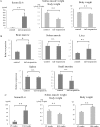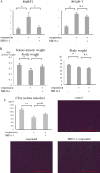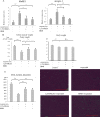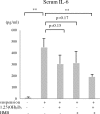Inhibition of interleukin-6 decreases atrogene expression and ameliorates tail suspension-induced skeletal muscle atrophy
- PMID: 29351340
- PMCID: PMC5774788
- DOI: 10.1371/journal.pone.0191318
Inhibition of interleukin-6 decreases atrogene expression and ameliorates tail suspension-induced skeletal muscle atrophy
Abstract
Background: Interleukin-6 (IL-6) is an inflammatory cytokine. Whether systemic IL-6 affects atrogene expression and disuse-induced skeletal muscle atrophy is unclear.
Methods: Tail-suspended mice were used as a disuse-induced muscle atrophy model. We administered anti-mouse IL-6 receptor antibody, beta-hydroxy-beta-methylbutyrate (HMB) and vitamin D to the mice and examined the effects on atrogene expression and muscle atrophy.
Results: Serum IL-6 levels were elevated in the mice. Inhibition of IL-6 receptor suppressed muscle RING finger 1 (MuRF1) expression and prevented muscle atrophy. HMB and vitamin D inhibited the serum IL-6 surge, downregulated the expression of MuRF1 and atrogin-1 in the soleus muscle, and ameliorated atrophy in the mice.
Conclusion: Systemic IL-6 affects MuRF1 expression and disuse-induced muscle atrophy.
Conflict of interest statement
Figures





Similar articles
-
Kampo formula hochu-ekki-to (Bu-Zhong-Yi-Qi-Tang, TJ-41) ameliorates muscle atrophy by modulating atrogenes and AMPK in vivo and in vitro.BMC Complement Med Ther. 2022 Dec 28;22(1):341. doi: 10.1186/s12906-022-03812-w. BMC Complement Med Ther. 2022. PMID: 36578084 Free PMC article.
-
β-Hydroxy-β-methylbutyrate reduces myonuclear apoptosis during recovery from hind limb suspension-induced muscle fiber atrophy in aged rats.Am J Physiol Regul Integr Comp Physiol. 2011 Sep;301(3):R701-15. doi: 10.1152/ajpregu.00840.2010. Epub 2011 Jun 22. Am J Physiol Regul Integr Comp Physiol. 2011. PMID: 21697520 Free PMC article.
-
Effects of tail suspension on serum testosterone and molecular targets regulating muscle mass.Muscle Nerve. 2015 Aug;52(2):278-88. doi: 10.1002/mus.24542. Muscle Nerve. 2015. PMID: 25524358
-
Branched-chain amino acids reduce hindlimb suspension-induced muscle atrophy and protein levels of atrogin-1 and MuRF1 in rats.Nutr Res. 2012 Sep;32(9):676-83. doi: 10.1016/j.nutres.2012.07.005. Epub 2012 Sep 17. Nutr Res. 2012. PMID: 23084640
-
Skeletal muscle atrogenes: From rodent models to human pathologies.Biochimie. 2019 Nov;166:251-269. doi: 10.1016/j.biochi.2019.07.014. Epub 2019 Jul 17. Biochimie. 2019. PMID: 31325479 Review.
Cited by
-
IL-6 and TNF are Potential Inflammatory Biomarkers in Facioscapulohumeral Muscular Dystrophy.J Neuromuscul Dis. 2024;11(2):327-347. doi: 10.3233/JND-230063. J Neuromuscul Dis. 2024. PMID: 38250782 Free PMC article.
-
Role of Fyn and the interleukin-6-STAT-3-autophagy axis in sarcopenia.iScience. 2023 Aug 25;26(10):107717. doi: 10.1016/j.isci.2023.107717. eCollection 2023 Oct 20. iScience. 2023. PMID: 37744036 Free PMC article.
-
AMP-Activated Protein Kinase as a Key Trigger for the Disuse-Induced Skeletal Muscle Remodeling.Int J Mol Sci. 2018 Nov 12;19(11):3558. doi: 10.3390/ijms19113558. Int J Mol Sci. 2018. PMID: 30424476 Free PMC article. Review.
-
A Piezo1/KLF15/IL-6 axis mediates immobilization-induced muscle atrophy.J Clin Invest. 2022 May 16;132(10):1-13. doi: 10.1172/JCI154611. J Clin Invest. 2022. PMID: 35290243 Free PMC article.
-
P38α-MAPK Signaling Inhibition Attenuates Soleus Atrophy during Early Stages of Muscle Unloading.Int J Mol Sci. 2020 Apr 15;21(8):2756. doi: 10.3390/ijms21082756. Int J Mol Sci. 2020. PMID: 32326654 Free PMC article.
References
-
- Foletta VC, White LJ, Larsen AE, Leger B, Russell AP. The role and regulation of MAFbx/atrogin-1 and MuRF1 in skeletal muscle atrophy. Pflugers Arch. 2011;461:325–35. doi: 10.1007/s00424-010-0919-9 - DOI - PubMed
-
- Cruz-Jentoft AJ, Baeyens JP, Bauer JM, Boirie Y, Cederholm T, Landi F, et al. Sarcopenia: European consensus on definition and diagnosis: Report of the European Working Group on Sarcopenia in Older People. Age Ageing. 2010;39:412–23. doi: 10.1093/ageing/afq034 - DOI - PMC - PubMed
-
- Bodine SC, Latres E, Baumhueter S, Lai VK, Nunez L, Clarke BA, et al. Identification of ubiquitin ligases required for skeletal muscle atrophy. Science. 2001;294:1704–8. doi: 10.1126/science.1065874 - DOI - PubMed
-
- Gomes MD, Lecker SH, Jagoe RT, Navon A, Goldberg AL. Atrogin-1, a muscle-specific F-box protein highly expressed during muscle atrophy. Proc Natl Acad Sci U S A. 2001;98:14440–5. doi: 10.1073/pnas.251541198 - DOI - PMC - PubMed
MeSH terms
Substances
LinkOut - more resources
Full Text Sources
Other Literature Sources

